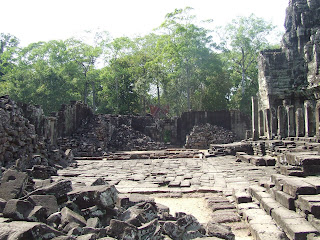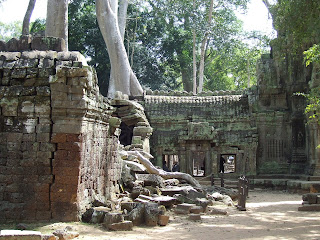 |
| Tree Temple, Siem Reap |
As I mentioned in my last post, Preah Khan was our favourite temple and we spent over two hours ambling around with frequent stops to enjoy the calm beauty and stillness.
When visiting places such as this my LTM is always drawn to the engineering and architectural aspects of the structures whereas I seem to be focused on what life might have been like actually doing the construction work and pictures of workers slaving away, heaving rocks, maybe chained together straining as in a tug of war fill my mind. I invariably wonder who started the whole thing, why and what was life like living there after it was completed. Who actually lived there? Why did it all go wrong ? There are some answers to such questions at Preah Khan because a sandstone stele was unearthed during the recovery of the temple around 1939. The inscription on this stone tells us that the temple was built by King Jayavarman V11 [ Similar name to those in Sri Lanka !] and was dedicated to his father. He actually lived there for a short time.
 |
| Helpful notice board at Preah Khan |
According to the records, the temple was built on the site of a battle between King Jayavarman V11 and the invading Chams. I think that the Chams were rulers somewhere in Viet Nam, South Viet Nam maybe. Anyway, King J was victorious and had this temple built on the battle site and named it Temple of the "Sacred Sword." The records also show that it was not only a Buddhist Temple and University with 15,000 monks but also a city with 100,000 officials, farmers and servants working hard to feed and otherwise service everyone. The city buildings were apparently built of timber - maybe the famous silk cotton trees - which is why they have not survived. King J seems to have been quite prosperous because mention is made of gold, silver and gems. He also built other temples, Ta Som and the famous Ta Prohm.
 |
| Library building, Preah Khan |
 |
| Preah Khan |
 |
| Preah Khan |
 |
| Preah Khan |
 |
| Preah Khan |
Preah Khan, Ta Som and Ta Prohm have all been partially reclaimed from the jungle but I believe that there is no intention of further reclaimation or extensive restoration but merely a maintainence program to retain the sites as something of Cambodia's historical record. Indeed, without the Angkor Wat area sites there would be greatly reduced tourism activity and therefore less injection of foreign funds into Cambodia's difficult economy.
 |
| Moat, Preah Khan |
Preah Khan is a walk through temple and we exited it through this gate. The Buddha statues lost their heads during Pol Pot's reign of terror, so we were told.
The three jungle temples are very similar, all constructed by or for King J so if anyone thinks that I have given a possibly incorrect location for a photo, please comment as I would like to know.
Ta Som was a smallish temple and here you got the feeling that the jungle was seemingly ready to once again consume the structures. The other two "tree" temples seem better known and there weren't many people around - except for some very tenacious girls selling postcards, bags and scarves. Even though I was carrying only my camera they pursued me relentlessly the entire length of the precinct to my car where they said I could get some money to buy their offerings!
There were mounds of rubble were everywhere. Look up when inside the narrow corridors and a patch of blue sky was to been seen through holes in the rock roof. I took comfort that an earthquake would be a big surprise in that part of the world but never the less made a decent exit.
The sight of this papaya flourishing amoung the rocks was amusing as we struggle to maintain such healthy specimans in our home garden.
This young Japanese lady grabbed my hands and pulled me into the picture too. Don't know why she wanted the foot pose though!
Ta Prohm's public exposure and popularity escalated with the movie Tomb Raider. Of the three "tree" temples it is the one where you get the feeling that given half a chance, the jungle will aggressively regain possession. The roots of the huge "strangler" fig trees hold tight to their prey leaving mere mortals to take note of their strength and intentions.
 |
| Tomb Raider tree, Ta Prohm |
King Jayavarman V11 seems to have been a loyal son and had this temple built at the end of the 12th Century and dedicated it to his mother. He certainy wished it to be known for all time that he was a man of action and wealth! A stele has also been found here, recording that there were about 80,000 people including 2700 officials and 615 dancers living in this temple.
 |
| Ta Prohm |
The overiding memory of these three temples is one of nature dominating man.
Once there were a few people, then huge populations with kings desirous of esablishing their power and strength. They had these cities, temples, universities and hospitals built altering the landscape as they did so. They fought wars to maintain and extend their power. They built another temple to celebrate victory - at least King Jayavarman V11 did. Had his feats and wealth recorded so that future comers would remember him and his achievements.
Then what?
For some reason, the people disappeared and Nature took back what was hers. And looks like it could do it again.
Makes one think.
What am I?
An "almost" speck on the page of time?





An amazing ancient culture to be found here. You were lucky to see it first hand.
ReplyDelete